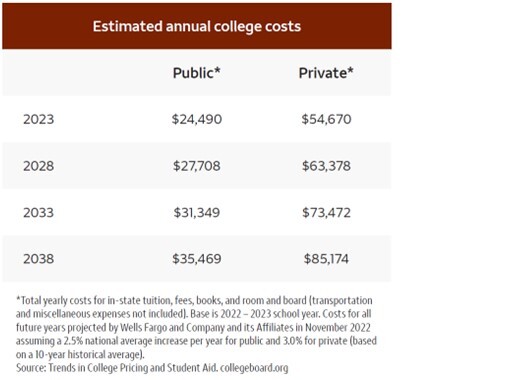Saving For Soaring College Costs
Whether your children or grandchildren are toddlers or teenagers, it’s only a matter of a time before they leave the family home, probably as they head off to college. The cost of sending just one child to college for four years can be staggering, and tuition and fee hikes regularly outpace inflation. Rather than sending your children or grandchildren into the world with a burden of student-loan debt, you can save to help cover at least a portion, if not all, of their higher-education expenses.
The College Board Advocacy and Policy Center reported that over the past decade college tuition and fees have rapidly increased. The table below demonstrates how average college costs would continue to increase at national average annual inflation rates.

Retirement vs. Education
As a parent or grandparent, you’re probably considering how to balance paying for college while planning for your retirement. Many families use some combination of savings, investments, borrowing, and financial aid (if available). There are options for financing college, but you can’t borrow for retirement. We believe saving for retirement should be the higher priority for many investors. If your employer offers a 401(k) plan, consider putting your savings there first, especially if there is a company match. After that, contribute to your child’s education account.
Save As Early As Possible
As you can imagine, the sooner you start saving for your child’s or grandchild’s education, the more money you may have later. One popular way to save is the 529 college savings plan. These are tax-advantaged accounts administered by states and institutions. Parents, grandparents, relatives, and friends can contribute. Other college savings accounts include custodial accounts in the child’s name and Coverdell Education Savings Accounts. Please consider the investment objectives, risk, charges and expenses carefully before investing in a 529 savings plan. The official statement, which contains this and other information, can be obtained by calling your Financial Advisor. Read it carefully before you invest.
Consider Financial Aid
A variety of factors play into financial aid eligibility. Don’t assume your child or grandchild won’t qualify for financial aid. Start thinking about applying for aid during high school. Visit the U.S. Department of Education’s Financial Aid Office for information about eligibility requirements, application deadlines, and types of federal financial loans and aid. For nonfederal financial aid, visit the College Board’s College Scholarship Service (CSS)/Financial Aid PROFILE® application for information on qualifying.
Go Private
Borrowing from a private lender is yet another option. Banks, credit unions, and other financial institutions provide private loans. Loans may be fixed or variable depending on the lender and the borrower’s credit rating. Other things to consider when borrowing from a private lender:
-
Private loans are generally more expensive because they may have higher fees.
-
If the student takes out the private loan, the student is responsible for repayment.
-
A parent may be required to co-sign a loan.
-
Look for family relationship discounts, automatic payment discounts, and graduation benefits.
It’s A Balancing Act
As you plan for the future, keep in mind the three C’s of college funding: consistency, communication, and compromise. Planning for retirement, managing your investment portfolio, and funding a college education is a balancing act. The trick is to plan ahead. We can help you come up with a plan that considers all aspects.
You Have Questions
• What can a financial advisor do for me?
• Are my investments performing the way they should?
• What is my next step?
• Are my investments performing the way they should?
• What is my next step?
